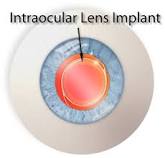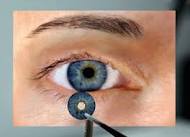Iris implants Surgery
The iris is the portion of the eye that provides the eye with its color and is unique to each individual. It serves to control the amount of light entering the eye. Absence or loss of the iris tissue of the eye can occur as a result of a congenital defect or as result of trauma or previous surgery. Individuals who lack an iris or who have an iris that cannot constrict properly often suffer from severe light sensitivity or photophobia. They may have significant glare at night time and often have impaired vision. The absence of the iris in one eye can be cosmetically disfiguring.
Currently in the U.S. there are no FDA approved artificial colored iris implants. However Dr. Pamel is one of a handful of surgeons across the country who is able to implant the Ophtec Artificial Iris Implant under a special compassionate use FDA trial. Patients' symptoms often resolve immediately and cosmetically the appearance of the eye with the artificial implant is often difficult to distinguish from a normal eye. (See photos below). The iris implants come in four colors: black, brown, blue and green. Opthec, Inc. cannot guarantee a perfect color match with the fellow eye.
Aniridia: This condition is a rare, bilateral hereditary absence of the iris. NYC aniridia patients often have some iris tissue but suffer from light sensitivity. The Ophtec Artificial Iris Implant can be used in patients with aniridia.
Previous eye surgery or iris trauma: Patients who have had prior eye surgery in which the iris has been damaged may be candidates for the iris implant. In addition patients who have sustained iris trauma causing loss of tissue can also be candidates for the iris implant.
Photos of patients before (left hand column) and after (center column) iris implantation are seen below. The last two columns on the right isolate the operative eye before and after artificial iris implantation
BACKGROUND: Aniridia (or partial aniridia) often occurs as a result of a penetrating ocular trauma. This condition may cause symptoms including glare, light sensitivity, reduced vision, and asymmetric appearance. Options for these patients include specialty contact lenses, corneal tattooing, and artificial iris implants. This article details six patients who experienced penetrating trauma with significant iris tissue loss and who chose to have an artificial iris implant.
CASE REPORTS: Six patients with traumatic aniridia were enrolled in a single-site, single-surgeon study. They were followed for one year postoperatively. All six were complex cases that had multiple eye problems, such as aphakia, corneal scarring, corneal graft rejection, and retinal detachment. All participants were male. All patients experienced decrease in glare and light sensitivity following artificial iris implant surgery. Two experienced improved best-corrected vision (BCVA). All six patients felt the cosmetic appearance of their affected eye improved.
CONCLUSIONS: The artificial iris device provides an effective means of treating traumatic aniridia. Optometrists often work with patients who have experienced a penetrating ocular trauma, with complete or partial aniridia as a complication. In cases in which nonsurgical means are not effective in returning the patient to comfort and productivity, an artificial iris implant should be considered.
Currently in the U.S. there are no FDA approved artificial colored iris implants. However Dr. Pamel is one of a handful of surgeons across the country who is able to implant the Ophtec Artificial Iris Implant under a special compassionate use FDA trial. Patients' symptoms often resolve immediately and cosmetically the appearance of the eye with the artificial implant is often difficult to distinguish from a normal eye. (See photos below). The iris implants come in four colors: black, brown, blue and green. Opthec, Inc. cannot guarantee a perfect color match with the fellow eye.
Aniridia: This condition is a rare, bilateral hereditary absence of the iris. NYC aniridia patients often have some iris tissue but suffer from light sensitivity. The Ophtec Artificial Iris Implant can be used in patients with aniridia.
Previous eye surgery or iris trauma: Patients who have had prior eye surgery in which the iris has been damaged may be candidates for the iris implant. In addition patients who have sustained iris trauma causing loss of tissue can also be candidates for the iris implant.
Artificial Iris Implant Procedure
The procedure is done as an outpatient surgery under local anesthetic. It can be done as a single procedure in which an incision is made into the limbus (the junction between the sclera or white part of the eye and the cornea or clear window of the eye) and the iris is inserted into the eye and sutured into position. Often it is done in combination with a cataract procedure, a lens implant procedure or a corneal transplant. The Ophtec Artificial Iris comes as an iris alone or as an iris with a lens implant in the center of the iris. The recovery will depend on the health of the eye prior to surgery but most often NYC / Manhattan artificial iris implant patients report a significant decrease in their light sensitivity early in the postoperative period. In addition, they notice a cosmetic improvement.Photos of patients before (left hand column) and after (center column) iris implantation are seen below. The last two columns on the right isolate the operative eye before and after artificial iris implantation
BACKGROUND: Aniridia (or partial aniridia) often occurs as a result of a penetrating ocular trauma. This condition may cause symptoms including glare, light sensitivity, reduced vision, and asymmetric appearance. Options for these patients include specialty contact lenses, corneal tattooing, and artificial iris implants. This article details six patients who experienced penetrating trauma with significant iris tissue loss and who chose to have an artificial iris implant.
CASE REPORTS: Six patients with traumatic aniridia were enrolled in a single-site, single-surgeon study. They were followed for one year postoperatively. All six were complex cases that had multiple eye problems, such as aphakia, corneal scarring, corneal graft rejection, and retinal detachment. All participants were male. All patients experienced decrease in glare and light sensitivity following artificial iris implant surgery. Two experienced improved best-corrected vision (BCVA). All six patients felt the cosmetic appearance of their affected eye improved.
CONCLUSIONS: The artificial iris device provides an effective means of treating traumatic aniridia. Optometrists often work with patients who have experienced a penetrating ocular trauma, with complete or partial aniridia as a complication. In cases in which nonsurgical means are not effective in returning the patient to comfort and productivity, an artificial iris implant should be considered.
Benefits of Artificial Iris Implant
Although many illness relating to the eyes happen so infrequently, it is still important to have such tools like artificial iris implants simply because of the life changing effects they can have on the patients. Those who need the implants cannot go outside without feeling discomfort from the sun.
The implants make it a lot easier for these people to live their every day lives in comfort. These artificial iris implants can reduce the glare of the sun as well as correcting Aphakia, a condition that leads to the loss of the eye's natural lens.
One of the best things about the implant is, it helps the patients look normal, give color to the eye and provide a normal sized pupil. However, this is not available everywhere in the world. Each implant is specially made and is unique for the patient that is in need of it. The implant is well tolerated, thin and uses flaps instead of haptics. By using the flaps to stay in place, the implants use a lot less pressure in the area in which they are placed.
The artificial iris implant can be used by a variety of people with different problems whether it be Aphakia, Aniridia or colobomas. The implant can even be used by those who want to change the color of their eyes strictly for cosmetic reasons.
Mainly, the implant is used for patients with oculocutaneous albinism and have no pigment in their eyes. Since the implant is so thin and made from ophthalmic-grade silicone, it poses little threat for complications and look more natural than contacts.














The implants make it a lot easier for these people to live their every day lives in comfort. These artificial iris implants can reduce the glare of the sun as well as correcting Aphakia, a condition that leads to the loss of the eye's natural lens.
One of the best things about the implant is, it helps the patients look normal, give color to the eye and provide a normal sized pupil. However, this is not available everywhere in the world. Each implant is specially made and is unique for the patient that is in need of it. The implant is well tolerated, thin and uses flaps instead of haptics. By using the flaps to stay in place, the implants use a lot less pressure in the area in which they are placed.
The artificial iris implant can be used by a variety of people with different problems whether it be Aphakia, Aniridia or colobomas. The implant can even be used by those who want to change the color of their eyes strictly for cosmetic reasons.
Mainly, the implant is used for patients with oculocutaneous albinism and have no pigment in their eyes. Since the implant is so thin and made from ophthalmic-grade silicone, it poses little threat for complications and look more natural than contacts.
Complications of cosmetic iris implants.
Cosmetic intraocular iris implants for the purpose of changing iris color have recently been developed; however, little is known about their safety. We report a patient who had bilateral implantation of colored silicone iris implants solely for cosmetic reasons. The rapid development of uveitis, corneal decompensation, and ocular hypertension resulted in the need for explantation of the implants. Placement of these devices should require specific medical indications and meticulous surgery with early and long-term evaluation







0 comments:
Post a Comment